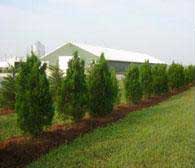Scientists say just three rows of trees around chicken houses can reduce dust, ammonia and smells.
This is the VOA Special English Agriculture Report.
Planting trees around poultry farms can improve air and water quality -- and relations with neighbors. Research has shown that just three rows of trees near poultry houses can reduce the release of dust and ammonia. They can also reduce the strong smell of ammonia gas.

The trees capture dust, ammonia and odors in their leaves. They also provide shade from the sun, so they reduce cooling costs in summer. And they act as a windbreak, so they reduce heating costs in winter. Trees can also improve water quality around farms by removing pollutants from soil and groundwater.
Several years ago, people were objecting to the odor of poultry farms on the Delmarva Peninsula in the eastern United States. Delmarva is where the states of Delaware, Maryland and Virginia come together.2000 farms there can each house an average of 75 thousand chickens.
Traditionally the farms used windows to provide fresh air in the chicken houses. Farmers rarely planted trees or tall crops around the buildings, so there would be no barrier to the airflow.
But then farms began to use new ventilation systems. Instead of windows, the new systems used tunnel fans to circulate air. The fans directed airflow from the poultry houses toward the homes of neighbors.
Researchers led by George Malone at the University of Delaware began dealing with the problem in 2000. They found that over a period of six years, planting three rows of trees reduced total dust and ammonia by more than half. And they found that odors were reduced by 18 percent.
The scientists reported their findings in 2008 at a meeting of the American Chemical Society.
For the first row nearest the fans, they generally suggested trees that lose their leaves in the fall or trees with waxy leaf surfaces. They suggested evergreen trees for the other two rows. Some trees work better than others. And what works in one area of the country may not work as well in others.
Farmers may think trees will take too long to grow and be effective. But some trees can grow quickly.
At least one-third of the Delmarva farms have planted trees, technically known as vegetative environmental buffers. The idea offers a way to cut pollution, save money and energy, and make the neighbors happy.
And that's the VOA Special English Agriculture Report, written by Jerilyn Watson. I'm Steve Ember.
ammonia: a colorless, pungent gas, NH3, extensively used to manufacture fertilizers and a wide variety of nitrogen-containing organic and inorganic chemicals 氨
windbreak: a hedge, fence, or row of trees serving to lessen or break the force of the wind 防风林;防风带
buffer: one that protects by intercepting or moderating adverse pressures or influences 缓冲区
Related stories:
Tree deaths in Western US linked to climate change
今天你“爱树”了吗?
Easily green your daily routine
Arbor Day (Day of Trees)
(Source: VOA 英语点津编辑)